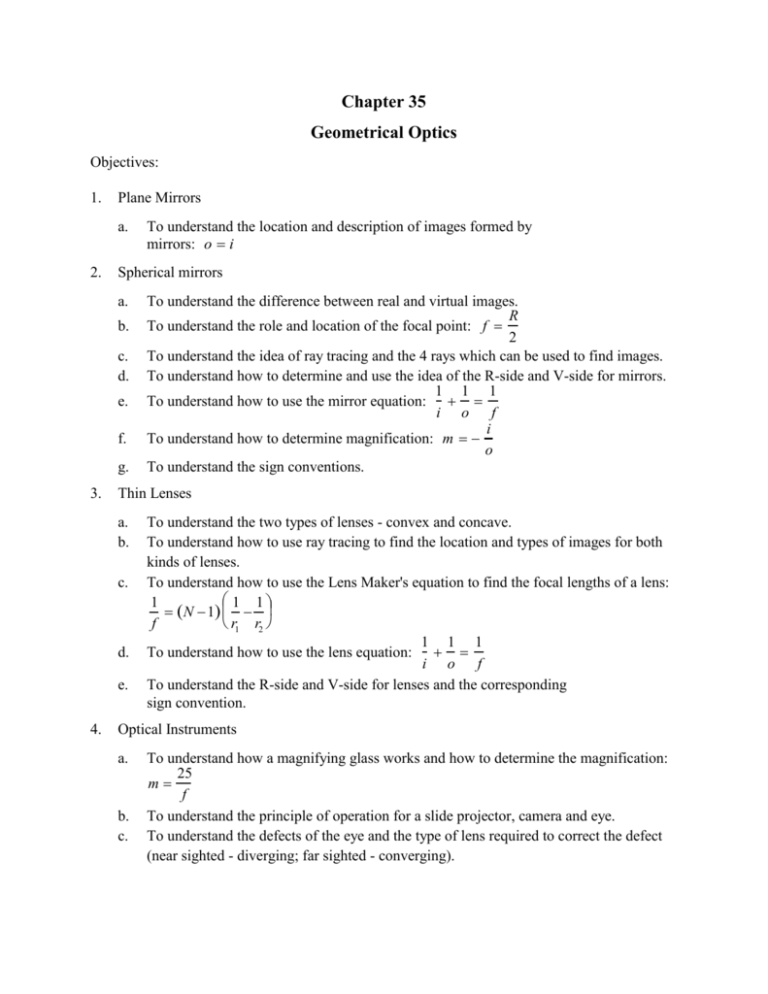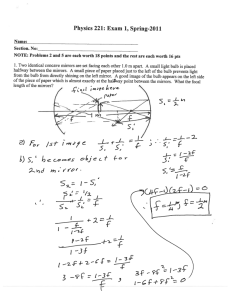Chapter 35
advertisement

Chapter 35 Geometrical Optics Objectives: 1. Plane Mirrors a. 2. Spherical mirrors a. b. c. d. e. f. g. 3. To understand the difference between real and virtual images. R To understand the role and location of the focal point: f 2 To understand the idea of ray tracing and the 4 rays which can be used to find images. To understand how to determine and use the idea of the R-side and V-side for mirrors. 1 1 1 To understand how to use the mirror equation: i o f i To understand how to determine magnification: m o To understand the sign conventions. Thin Lenses a. b. c. d. e. 4. To understand the location and description of images formed by mirrors: o i To understand the two types of lenses - convex and concave. To understand how to use ray tracing to find the location and types of images for both kinds of lenses. To understand how to use the Lens Maker's equation to find the focal lengths of a lens: 1 1 1 N 1 f r1 r2 1 1 1 To understand how to use the lens equation: i o f To understand the R-side and V-side for lenses and the corresponding sign convention. Optical Instruments a. b. c. To understand how a magnifying glass works and how to determine the magnification: 25 m f To understand the principle of operation for a slide projector, camera and eye. To understand the defects of the eye and the type of lens required to correct the defect (near sighted - diverging; far sighted - converging). d. To understand how a compound microscope works and how to determine the 25 s magnification: m fo f e e. To understand how a telescope works and how to determine the magnification: f m o fe Chapter 35 problems 1. How tall must a plane mirror be to allow you to see your entire reflection head to toe? Assume that you are 1.62 m tall and that your eyes are 0.12 m from the top of your head. 2. A man stands with his nose 4 inches from a concave shaving mirror of radius 16 inches. What is the distance from the mirror to the image of his nose? 3. A concave mirror forms a real image which is twice the size of the object. If the object is 20 cm form the mirror, what is the radius of curvature of the mirror? 4. An object 10 cm high is placed 40 cm in front of a positive lens of focal length 30 cm. Where is the image and what is its size? 5. An object 10 cm high is placed 40 cm in front of a negative lens of focal length 30 cm. Where is the image and what is its size? 6. A converging lens has a radius of curvature of 25 cm and is made of glass. What is the focal length of this lens? 7. A photographer wishes to take a picture of a (gender independent) bathing beauty unnoticed from a distance of 100 m. If the person is 2 m long and the image on the film is to be 1.2 cm, what focal length lens should be used? 8. The lens of a slide projector has a focal length of 15 cm. Where should the slide be placed so that the slide will be in focus 5 m from the projector? Mirrors Rays 1. 2. 3. 4. Parallel to axis reflected through f Through f reflected parallel to optical axis Through center of curvature reflected straight back Equal angles with vertex Equations 1 1 1 i o f i m o Sign convention R-side - side where real objects are formed - positive V-side - side where virtual objects are formed - negative Mirrors R-side is side light comes from V-side is back of mirror "Normal Signs" Concave o, R, f i Convex o R, f, i positive positive or negative positive negative Exception Virtual Object converging light would have formed an image if it had not been reflected from the mirror LENSES Rays 1. 2. 3. Parallel to axis reflected through f Through f reflected parallel to optical axis Through center of lens goes straight through Equations (same as mirrors) 1 1 1 i o f i m o Sign convention (same as mirrors) R-side - side where real objects are formed - positive V-side - side where virtual objects are formed - negative Lenses (opposite mirrors) V-side is side light comes from R-side is the other side Signs for Lenses 1. Radius of curvature (+) if center of curvature is on R-side (-) if center of curvature is on V-side 2. Focal length (+) for converging lenses (-) for diverging lenses 3. Image distance (+) means image is on R-side (-) means image is on V-side 4. Object distance (+) Normal case (object is on side light comes from) (-) Virtual object (object is on V-side i.e. converging light would have formed an object if it had not been for the lens)







